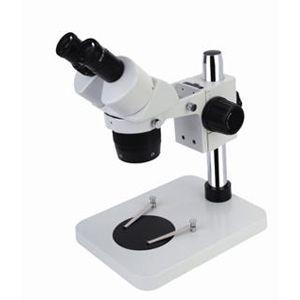Stereo microscopes, also known as dissecting microscopes or stereoscopic microscopes, are a type of optical microscope specifically designed to provide a three-dimensional (3D) view of specimens at low magnification. Unlike compound microscopes that offer high magnification of a flat, 2D image, stereo microscopes excel at offering magnified depth perception for observing the surface features and manipulating objects too large or thick for traditional microscopes.
Here's a breakdown of the key applications of stereo microscopes:
l Dissection and Microscopic Surgery: The 3D view and comfortable working distance provided by stereo microscopes make them ideal for dissecting biological specimens like insects, plants, or small animals. The ability to manipulate tools under magnification allows for precise work during dissections or delicate microsurgeries.
l Biological Research: Stereo microscopes are widely used in various biological research fields. They are instrumental in studying the external morphology of organisms, observing live specimens in their natural state, and examining small tissues or organs before further processing for higher magnification analysis.
l Entomology (Study of Insects): Due to their size and intricate features, insects are prime candidates for observation under a stereo microscope. Entomologists use them to identify species, study insect morphology, and examine external anatomy in detail.
l Botany (Study of Plants): Stereo microscopes are valuable tools in botany for studying plant structures like flowers, seeds, leaves, and stems. The 3D view allows for detailed observation of surface features, pollen grains, or small plant organisms.
l Quality Control and Industrial Applications: In various industries, stereo microscopes are used for quality control purposes. They are helpful for inspecting the surface features of manufactured parts, identifying defects, or observing soldering points on circuit boards.
l Gemology and Jewelry Making: Examining gemstones and other jewelry components for clarity, inclusions, or cutting quality is often done using stereo microscopes. The 3D view and comfortable working distance allow for detailed observation and manipulation of these small objects.
l Education and Training: Stereo microscopes are valuable tools for science education at all levels. Students can use them to observe biological specimens in a classroom setting, gain a better understanding of 3D structures, and practice basic microscopy techniques.
Advantages of Stereo Microscopes:
l 3D Visualization: The key advantage is the ability to see a magnified object in 3D, providing depth perception crucial for tasks like dissection or manipulating small objects.
l Low Magnification: Stereo microscopes offer lower magnification than compound microscopes, which makes them ideal for observing larger specimens that wouldn't be suitable for high magnification viewing.
l Long Working Distance: The working distance (space between the objective lens and the sample) is typically larger compared to compound microscopes. This allows for ample space to manipulate tools or your hands under the microscope for dissections or other procedures.
l Incident and Transmitted Illumination: Many stereo microscopes offer both incident lighting (from above) and transmitted lighting (from below) for added versatility. This allows for observing surface features or seeing through slightly transparent samples.
Overall, stereo microscopes are a versatile tool across various fields due to their ability to provide a magnified 3D view at low magnification with a comfortable working distance. They are instrumental for researchers, educators, and professionals in various industries who need to observe, manipulate, and analyze objects in three dimensions at a magnified scale. You might also want to know How to Choose the Right Stereo Microscope for My Needs.

